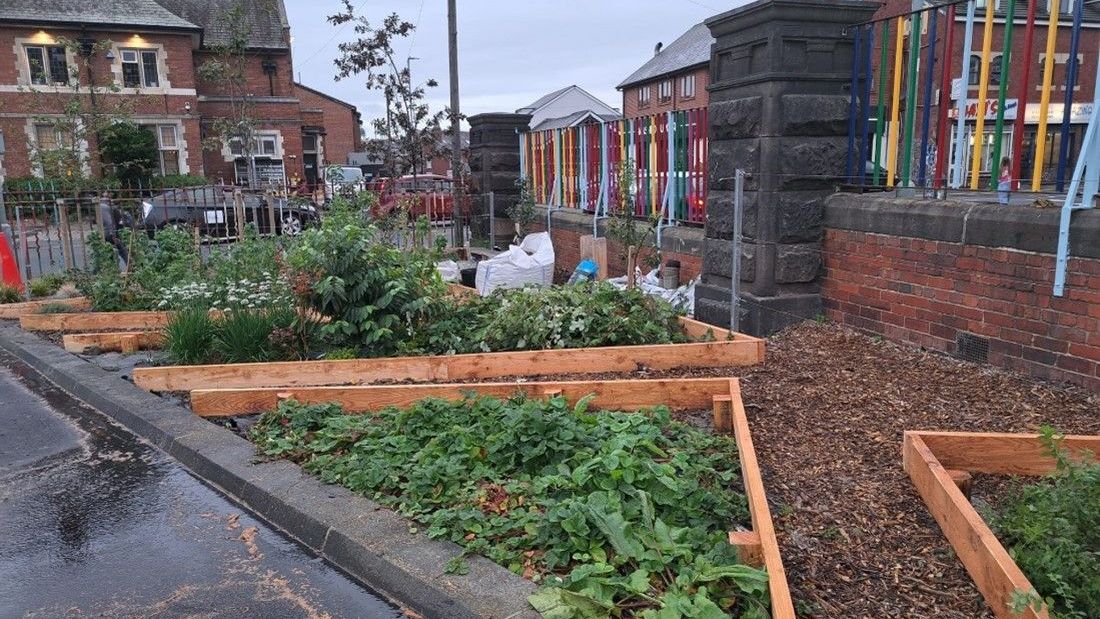Leeds City Council unveils Royal Park in Hyde Park, a vibrant community space with educational vegetable beds, an outdoor gym, and diverse play areas. The park’s transformation from the former Royal Park School site celebrates community spirit and environmental stewardship, offering a hub for learning, exercise, and shared memories.
What are the features and benefits of the new Royal Park in Hyde Park, Leeds?
Royal Park in Hyde Park, Leeds, is a transformative community park offering:
– Vegetable growing beds and a fruit orchard for local produce and agricultural education.
– An outdoor gym and multi-use games area promoting physical health.
– Diverse play features for children encouraging active play.
– Landscaping that supports biodiversity with wildflowers for pollinators.
This green space is a hub for community life, learning, and environmental stewardship.
Rebirth of a Community Landmark
The transformation of the former Royal Park School site into a new, vibrant community park marks a significant milestone for the Hyde Park area. Closed in 2004 and subsequently demolished, the space where the school once stood had been a subject of community discussion for many years. The site’s revitalization was finally set in motion in 2020 when Leeds City Council and community members came together to repurpose it for the public’s benefit. These early talks were pivotal; they revealed a strong community aspiration for a park that would embody more than just green space. Ideas flourished, including community gardens and educational initiatives, aimed at fostering a sustainable relationship between residents and their environment.
From its conception, the park was envisioned as a center of communal life, a sentiment echoed by Councillor Mohammed Rafique, who oversees the city’s climate, energy, environment, and green spaces. “It’s wonderful to see Royal Park finally open to the public, and we are delighted with how it’s turned out,” he stated. Emphasizing the park’s role in bringing people together, Councillor Rafique reflected on the cohesive spirit that Royal Park School once embodied. Acknowledging the community’s patience, he celebrated the park’s opening and invited residents to explore its features, including a historical sign recounting the site’s past and transition.
A Green Space for Growth and Well-being
The newly opened Royal Park stands as a beacon of community-driven development, offering a wide range of facilities designed to nurture both personal growth and ecological well-being. The park boasts vegetable growing beds and a fruit orchard; these not only provide residents with fresh produce but also serve as living classrooms for gardening and agricultural education. Through engaging with the land, individuals of all ages can learn the value of sustainability and the joy of nurturing life from seed to harvest.
Beyond horticulture, the park caters to the community’s physical health with the addition of an outdoor gym adjacent to a multi-use games area. This new installation encourages an active lifestyle, accessible to all fitness levels and ages. For children, the park offers a diverse range of play features, catering to different age groups and play styles. These elements come together to form a versatile outdoor space where education, exercise, and leisure converge, creating a holistic environment for community members to thrive.
Royal Park’s commitment to environmental stewardship extends to its landscaping choices. Wildflowers are strategically planted to offer not only a splash of seasonal color but also to serve as a food source for a variety of pollinating insects. This focus on biodiversity enhances the park’s beauty and contributes to the health of the local ecosystem, underlining the idea that green spaces can serve multiple purposes within a community.
A Legacy Remembered and a Future Anticipated
While Royal Park looks forward to fostering new memories, it also honors its origins. Features like the benches from the school days serve as poignant reminders of the site’s heritage, bridging the gap between past and present. The park is more than a recreational area; it stands as a testament to the neighborhood’s history and communal ties. The efforts to preserve and share the narrative of Royal Park School through informational signage ensure that its legacy remains a part of the community’s collective memory.
The creation and opening of Royal Park have been met with enthusiasm and support from various neighborhood representatives, including the Hyde Park Neighbourhood Forum. Their participation in the official opening highlights the strong collaborative spirit that has driven this project from its inception. This new park is expected to become a hub of community life, echoing the role of the former school as a gathering place.
The park’s future is filled with potential. As the community continues to engage with and shape its evolving landscape, Royal Park is poised to become a cornerstone of Hyde Park’s identity. It promises to be a place where residents can not only enjoy leisure and exercise but also forge bonds with their neighbors and the natural world around them. This green oasis in the heart of the city is set to be a cherished resource for current and future generations, demonstrating how urban spaces can be thoughtfully repurposed to enrich the lives of those who use them.
For more information on Royal Park or to get involved with the community initiatives, visit the Leeds City Council’s webpage on Royal Park.
- The new Royal Park in Hyde Park, Leeds, offers vegetable growing beds, an outdoor gym, diverse play areas, and landscaping for biodiversity.
- The park was transformed from the former Royal Park School site, showcasing community spirit and environmental stewardship.
- The park serves as a hub for learning, exercise, and shared memories, embodying communal life.
- Royal Park provides facilities for gardening, agricultural education, physical health, and diverse play experiences.
- The park honors its heritage while looking towards the future, aiming to become a cornerstone of Hyde Park’s identity.
